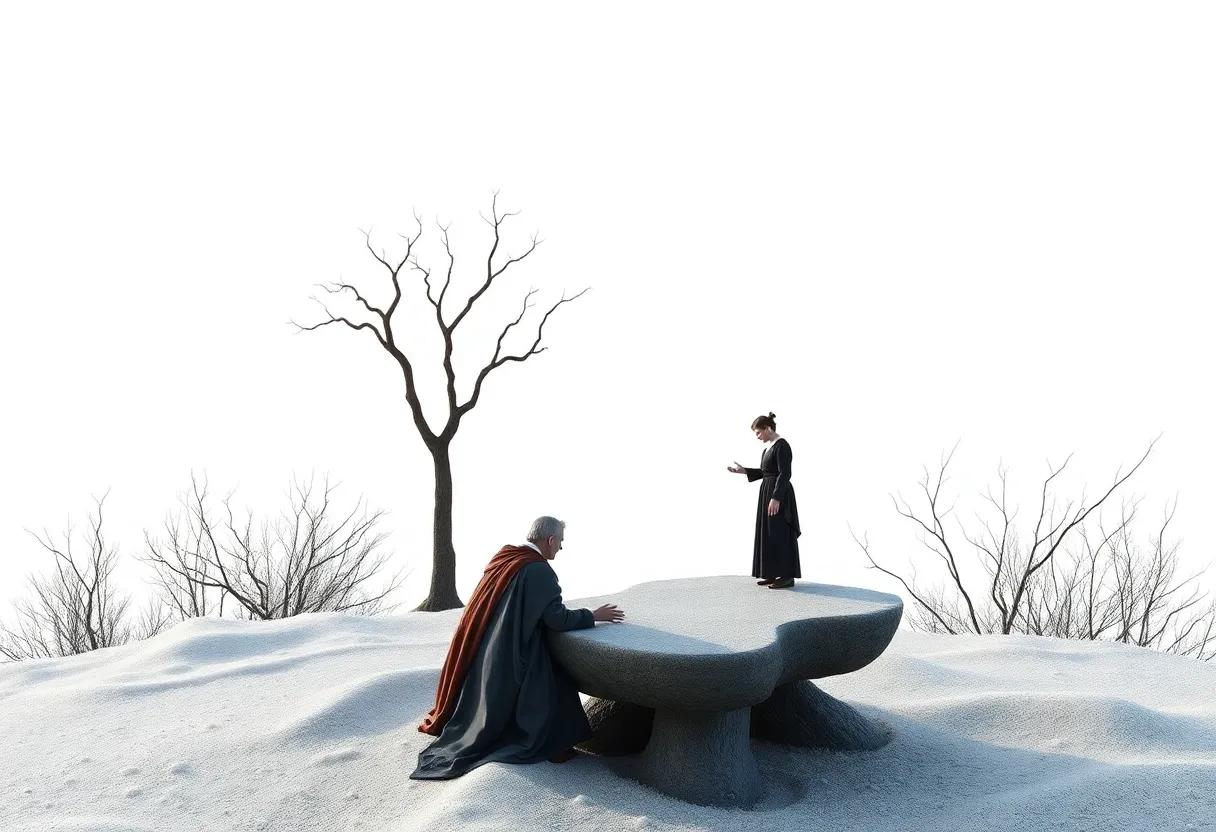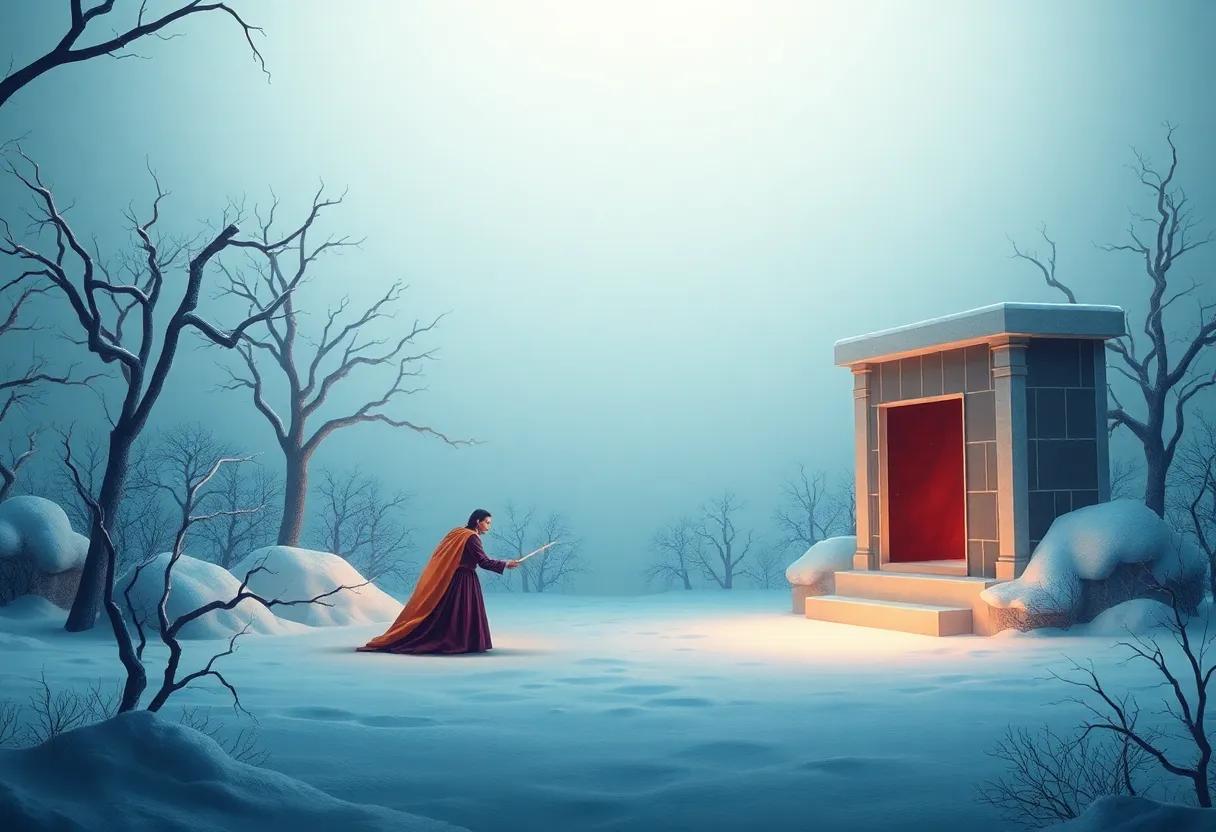In the realm where time folds upon itself and the boundaries between loss and renewal blur, Shakespeare’s The Winter’s tale stands as a compelling tapestry of human frailty and forgiveness. invites readers to journey beyond the surface of this enigmatic play-exploring its intricate dance with themes of jealousy, redemption, and the elusive nature of time. This review delves into the layers of Shakespeare’s narrative, offering a balanced contemplation of its enduring relevance and the emotional depths that continue to resonate centuries after its creation.
exploring the Themes of Time and Forgiveness in The Winter’s Tale through a contemporary Lens

In The Winter’s Tale,the passage of time serves not only as a narrative device but as a profound metaphor for healing and conversion. When we view this through a contemporary lens, the play’s exploration of time resonates deeply with the modern experience of forgiveness and personal growth. time is portrayed as a quiet, relentless force that both wounds and mends-offering characters a chance to confront painful mistakes, learn from them, and ultimately redefine their relationships. This cyclical notion challenges us to reconsider how we perceive regret and reconciliation in our own lives, emphasizing that forgiveness is a process, not an event.
forgiveness in Shakespeare’s work transcends mere pardon; it demands vulnerability and courage. In today’s context, this theme highlights the struggle between human fallibility and the desire for redemption. The interplay of grief, denial, and acceptance culminates in moments that speak to universal truths-how the past shapes but does not imprison us, and how grace can emerge from the ashes of sorrow. Consider the following elements that illustrate this intricate dance of time and redemption:
- Elapsed Time: Generations pass, allowing wounds to soften and perspectives to shift.
- Memory and Forgetting: The tension between remembering pain and choosing to forgive.
- Reunion and Renewal: The power of restored relationships as a symbol of hope.
| Theme | Contemporary Parallel |
|---|---|
| Time as Healer | Therapeutic processes that allow emotional recovery |
| Forgiveness as Choice | Deliberate acts in conflict resolution and restorative justice |
| redemption through Connection | Rebuilding trust in fractured relationships |
The Intricate Balance of Tragedy and Comedy in The Winter’s tale and Its Emotional Impact on Readers

Shakespeare’s The Winter’s Tale masterfully wields the dual forces of tragedy and comedy to evoke a profound emotional spectrum. The play’s early acts plunge the audience into the depths of jealousy, loss, and despair, only to gently transition into moments of levity and forgiveness that culminate in a bittersweet redemption. this delicate interplay invites readers to navigate the complexity of human experience, where grief and joy coexist, challenging the notion of a singular emotional response. The tragic downfall of King Leontes starkly contrasts with the joyous reunion and symbolic rebirth that follow, making the emotional journey both unpredictable and deeply resonant.
This emotional duality is further enriched through Shakespeare’s use of contrasting characters, settings, and tonal shifts, which serve as a reminder of life’s inherent contradictions. consider the emotional roadmap below, illustrating how key emotions ebb and flow throughout the narrative:
| Act | Dominant Emotion | Tone |
|---|---|---|
| 1-2 | Jealousy & Suspicion | Dark & Intense |
| 3 | Loss & Grief | Somber & Reflective |
| 4-5 | Forgiveness & Renewal | Hopeful & Joyous |
Such a nuanced emotional architecture fosters a unique connection with readers, as it mirrors the unpredictable rhythms of real life. It encourages audiences to reflect on themes of repentance, the passage of time, and the possibility of healing even in the wake of profound tragedy. The Winter’s Tale thus becomes not merely a story to be witnessed but an emotional voyage that lingers long after the final scene, inviting endless contemplation on the resilience of the human spirit.
- Shakespeare’s strategic tonal shifts prompt empathy and catharsis.
- The juxtaposition of bleakness and humor adds depth to characters’ humanity.
- Readers experience a cyclical emotional transformation, from despair to hope.
Character development and Transformation: A deep Dive into Leontes and Perdita’s Journeys
Leontes’ arc is a haunting exploration of jealousy, guilt, and ultimate redemption. From the moment he succumbs to irrational suspicion, bruising the bonds of family and friendship, his descent feels both tragic and deeply human. Yet, what sets his journey apart is not merely his downfall but the painstaking path toward atonement and self-awareness. This transformative process is captured through his shift from rigid authority to humble repentance, an evolution that reveals Shakespeare’s profound understanding of the complexities of regret and forgiveness. Leontes embodies the turmoil of a soul seeking restoration, teaching us that true change often demands the courage to confront our darkest mistakes.
- Initial State: Proud, impulsive, consumed by suspicion
- Turning Point: The exposure of his error and resulting personal losses
- Resolution: Acceptance, remorse, and gradual healing over time
Parallel to Leontes is Perdita, whose trajectory is marked by innocence, resilience, and rediscovery. Uprooted from her royal origin and raised amid pastoral simplicity, her growth reflects the transformative power of identity and love reclaimed. Her journey from obscurity to recognition highlights themes of renewal and the enduring impact of nurture over nature. Through Perdita, we witness a reversal of fortune that is less about destiny and more about the reclamation of agency and belonging. Her grace and fortitude serve as a beacon of hope, illustrating how innocence can endure and flourish despite adversity.
| Character | Key Traits | Symbolic Role |
|---|---|---|
| Leontes | Jealous, remorseful, evolving | Human frailty and redemption |
| Perdita | Innocent, resilient, loving | Renewal and identity reclaimed |
symbolism and Imagery that Enrich the narrative and Enhance the Storytelling Experience

William Shakespeare’s The Winter’s Tale vibrantly weaves symbolism and imagery throughout its narrative, transforming the story into a profound meditation on time, loss, and renewal. the recurring motif of the changing seasons mirrors the emotional landscape of the characters,especially the harsh winter that symbolizes jealousy and despair giving way to the blossoming of spring as a metaphor for forgiveness and rebirth. The stark contrast between the cold, barren courts of Sicilia and the fertile, sunlit plains of Bohemia visually reinforces the thematic tension between rigidity and freedom, confinement and release.
Rich in symbolic imagery, the tale utilizes objects and events that resonate on multiple levels. Consider the innocent stone statue of Hermione, which not only evokes the passage of time but also represents the enduring nature of love and art as forces capable of transcending human frailty. Elements such as:
- The Oracle’s prophecy – a narrative fulcrum embodying fate’s inevitability
- Sheep-shearing festival – symbolizing communal unity and simple joys amidst turmoil
- The shattered family – metaphors for fractured innocence and hope
| Symbol | Meaning | Narrative Role |
|---|---|---|
| Statue of Hermione | love’s endurance and resurrection | Climactic revelation and hope |
| Winter | Jealousy,punishment | Setting emotional tone of tragedy |
| Bohemia | Freedom,forgiveness | Space for redemption and rebirth |
The Role of Magical Realism and Its Effect on the Play’s Overall Atmosphere and Reader Engagement

Shakespeare weaves elements of magical realism with subtlety, allowing the surreal to gently infiltrate the fabric of reality without shattering believability. This seamless blending of the mystical – from the haunting statue of Hermione that seemingly breathes life to the symbolic use of time’s passage – adds a dreamlike quality that both intrigues and ensnares the audience’s imagination. The play’s atmosphere oscillates between somber tragedy and hopeful rebirth, a duality heightened by the ethereal moments that feel suspended outside normal chronology. The magical realism acts as a bridge, connecting the emotional truths of the characters with the universal themes of forgiveness and renewal, encouraging the audience to engage not just intellectually but viscerally.
Such fantastical elements enhance reader and viewer engagement by inviting a suspension of disbelief that opens space for reflection and emotional investment. The interlacing of reality and the supernatural deepens the narrative texture, encouraging interpretations beyond the literal-readers find themselves dwelling on themes of time’s fluidity and the redemptive power of faith and forgiveness. Consider the following effects that magical realism imparts on the play’s overall experience:
- Heightened emotional resonance through symbolic imagery and miraculous occurrences
- Layered narrative structure that rewards active contemplation
- An open-ended atmosphere where reality and fantasy coexist ambiguously
- Empowerment of thematic motifs like time’s cyclical nature and restorative grace
| Element of Magical Realism | Effect on Atmosphere | Impact on Engagement |
|---|---|---|
| Hermione’s Statue Resurrection | Mystical and awe-inspiring | sharpens audience anticipation and hope |
| Time Jump between Acts | Mysterious and fluid | Provokes curiosity about transformation and fate |
| Oracle’s prophecies | Foreboding yet enlightening | Engages viewers’ interpretive faculties |
How The Winter’s Tale Addresses Issues of Jealousy,Redemption,and the Human Condition
At the heart of this Shakespearean drama lies a profound exploration of jealousy,a corrosive force that ignites the tragic unraveling of relationships. King Leontes’ sudden and unfounded suspicion towards his wife Hermione drives the narrative into dark territories of betrayal and despair. Yet, through the unfolding events, the play paints jealousy not merely as a destructive emotion but also as a catalyst for self-awareness. The tension between mistrust and love encapsulates the vulnerability of the human psyche,exposing how easily reason can be subverted by emotional turmoil.
Equally compelling is the theme of redemption, woven with a delicate thread of time’s healing touch. Shakespeare juxtaposes moments of intense suffering with eventual forgiveness and renewal, underscoring the resilience embedded within the human condition. The passage of time becomes almost a character itself,methodically eroding pain and enabling transformation. This interplay is summarized below:
| Theme Aspect | Manifestation | Impact |
|---|---|---|
| Jealousy | Leontes’ suspicion | Destruction of trust |
| Redemption | Reunion after years | Restoration of harmony |
| Human condition | Grief and forgiveness | Endurance and hope |
Within the fabric of the play, Shakespeare invites us to reflect on the cyclical dynamics of human flaws and virtues. The narrative’s ability to oscillate between tragedy and comedy affirms that life itself is an intricate balance of darkness and light.Through characters who falter and then rise, the story showcases not only the tragedy of human error but also the enduring power of empathy and change. In embracing both pain and redemption, the play holds a mirror to our own struggles, offering lessons that remain poignantly relevant in any era.
Examining the Play’s Structure and Pacing for a More Immersive Literary Experience
Shakespeare’s The Winter’s Tale challenges conventional dramatic conventions with its bold division between tragedy and comedy, creating a rhythm that pulses with emotional extremes.The play’s first three acts unveil a tense, claustrophobic atmosphere filled with suspicion and fury, while the latter acts shift gears into pastoral reprieve and eventual reconciliation. This structural dichotomy, rather than feeling disjointed, enhances the audience’s immersion by mirroring the unpredictable flow of human experience – where despair and hope collide in unpredictable succession.
Examining the pacing reveals deliberate choices that manipulate time itself – the famous ‘time jump’ of sixteen years is not merely a narrative device but a thematic heartbeat, allowing redemption to emerge out of what feels like irrevocable loss. The interplay of rapid scene changes in the early acts versus the slower,more reflective rhythm of the final scenes invites viewers to navigate:
- Heightened tension through sharp,urgent exchanges
- Emotional release during the pastoral interlude
- Quiet contemplation as forgiveness gradually unfolds
| Structural Element | Effect on Viewer |
|---|---|
| Rapid first act pacing | Builds suspense and unease |
| Sixteen-year time lapse | Symbols rebirth and healing |
| Extended final scenes | Foster emotional resolution |
Detailed Recommendations for Readers New to shakespeare and Returning Fans Alike
For those embarking on their first journey into Shakespeare’s rich tapestry,The Winter’s Tale offers a uniquely accessible blend of tragedy and comedy that can serve as an inviting gateway. To truly appreciate the play’s delicate balance of intense emotions and whimsical redemption, readers might consider keeping a few focal points in mind. Pay attention to the evolution of characters like Leontes and Perdita-their arcs not only drive the narrative but also highlight Shakespeare’s mastery in portraying human frailty and forgiveness. Utilizing annotated editions or modern translations alongside the original text can illuminate some of the Elizabethan language and symbolism that might initially feel distant.
For seasoned Shakespeare enthusiasts, delving into the thematic intersections of time and reconciliation in The Winter’s Tale opens up avenues for profound reflection. Re-examining the play with an eye toward its inventive structure-such as the dramatic 16-year leap-invites richer interpretations of growth, loss, and the cyclical nature of life. A recommended approach is to engage in comparative readings, juxtaposing The Winter’s Tale with Shakespeare’s other late romances, like The Tempest and cymbeline, to appreciate their shared motifs and divergent resolutions. Below, a simple guide highlights key thematic pivots and suggested reading approaches:
| Aspect | new Readers | Returning Fans |
|---|---|---|
| Language | Use annotated editions; | Explore original text nuances; |
| Characters | Focus on main arcs; | Analyze subtle transformations; |
| Themes | Identify key ideas like jealousy and redemption; | Compare with other late romances; |
| Structure | note the 16-year gap; | Reflect on narrative innovation; |
The Winter’s Tale in Modern Adaptations and why Its Themes Remain Relevant Today
Modern creators continually revisit this timeless narrative, breathing fresh life into its motifs through innovative lenses such as contemporary theater, film, and even multimedia installations. These adaptations often highlight the cyclical nature of human emotions-jealousy, regret, forgiveness, and rebirth-woven seamlessly into today’s social and cultural fabric. The story’s exploration of time as a healing force resonates profoundly, reminding us that pain and separation, no matter how acute, can evolve into growth and renewal with patience and understanding.
What makes this tale resonate deeply across generations is its universal reflection on human fragility and resilience. Themes of redemption, lost innocence, and the power of reconciliation are not confined to the Elizabethan past but pulse vividly in modern contexts. Consider how these core themes manifest today:
- reconciliation in fractured families and communities
- The struggle against unjust accusations and the quest for truth
- The endurance of love transcending time and circumstance
- The tension between jealousy and forgiveness in personal relationships
| Modern Adaptation | Medium | Notable Element |
|---|---|---|
| The Winter’s Tale – Royal shakespeare Company (2021) | Theater | Emphasis on restoration and environmental imagery |
| Winter’s Tale (2014) – Film | Film | Blends magical realism with modern romance |
| Digital Interactive Experience | Multimedia Installation | User-driven narrative on forgiveness and time |
The Use of Nature and Setting as a Reflection of Internal Emotional States in the Play
Throughout the play, the landscape is more than a mere backdrop; it acts as an emotional mirror to the characters’ inner turmoil and growth.From the cold, oppressive atmosphere of Sicilia to the wild, untamed beauty of Bohemia, nature itself seems entwined with the narrative’s psychological ebb and flow. Leontes’ jealousy and suspicion cast a shadow over Sicilia, where the barren, wintry surroundings reflects his chilling descent into irrational rage. Conversely, Bohemia’s vibrant, pastoral settings symbolize renewal and forgiveness, embodying the possibility of healing after devastation.
This alignment between setting and sentiment is amplified through the use of contrasting imagery and symbolic elements, which can be summarized as:
- Winter – coldness, isolation, mistrust
- Spring and Growth – hope, forgiveness, rebirth
- The Ocean and island – exile, mystery, transformation
| Scene | Nature-emotion Link | Impact on Plot |
|---|---|---|
| Sicilian Courtyard | Winter chill reflects suspicion | Jealousy leads to tragedy |
| Bohemian Pasture | Spring tones invite reconciliation | Characters find redemption |
| Sea Cave | Isolation with a flicker of hope | Miscegenation and secret survival |
By weaving nature deeply into the emotional fabric of the plot, Shakespeare offers more than scenic descriptions. He invites the audience into a world where the external and internal intertwine, making the environment a silent narrator of the characters’ journey from despair to grace.
Technical Analysis of the Language and Dialogue that Defines The Winter’s Tale’s Unique Voice
The Winter’s Tale employs a rich tapestry of language, delicately balancing poetic fluidity with raw emotional dialogue. The play’s voice is marked by an interweaving of shakespeare’s philosophical musings and colloquial vibrancy, creating a spectrum that captures the human experience in its entirety. Characters like Leontes and Paulina communicate with a depth that transcends mere words: their speech oscillates between lyrical introspection and impassioned pleas,embodying the fragility and resilience that define the play’s thematic core. Furthermore,the use of pastoral imagery and symbolic metaphors amplifies this dynamic; pastoral scenes lightening the narrative’s weight while also emphasizing themes of rebirth and renewal.
the distinctiveness of the dialogue is further highlighted through strategic linguistic contrasts and tempo shifts. For instance:
- Raw,fragmented speech during moments of jealousy and despair,mirroring the characters’ turbulent mental states.
- Formal, rhythmic verse in royal and prophetic declarations, underscoring authority and fate.
- Playful banter around the *clown* scenes, offering lightness and humanizing the narrative.
This layering creates a distinctive voice,one that evolves alongside time shifts within the plot-from the tragic to the comedic,and finally to the redemptive. The table below illustrates some key stylistic features used throughout the play, emphasizing how language shapes its shifting moods:
| Stylistic Aspect | Function | Example |
|---|---|---|
| Imagery | Evokes themes of nature and renewal | “The sea hath fish, / Walls have their chinks” |
| Tone Shift | From tragedy to comedy, reflecting time’s passage | Leontes’ jealousy → playful shepherds |
| Diction | Varies from lofty to colloquial | Paulina’s formal rhetoric vs. Clown’s simplicity |
Why The Winter’s Tale Deserves a Place in your Reading List This Year
In a literary landscape often dominated by tragedy and romance, The Winter’s Tale offers a refreshing blend of both, enveloped in themes of forgiveness and rejuvenation. Shakespeare’s masterful use of time as a narrative device challenges conventional storytelling-where years pass in the blink of an eye, healing old wounds and reshaping characters’ destinies. Its seamless shift from an intense, almost claustrophobic jealousy to a pastoral, almost magical redemption arc invites readers to explore the resilience of the human spirit. The play’s nuanced characters,from the flawed King Leontes to the innocent Perdita,are not just figures on a page but reflections of our own struggles and triumphs.
What sets this work apart is its profound exploration of second chances, making it remarkably relevant today. The story’s rich symbolism, combined with moments of humor and heartfelt emotion, creates a tapestry that is both timeless and universal. Including The Winter’s Tale in your reading list means embracing:
- Complex themes of jealousy, loss, and reconciliation, captured with poetic grace.
- A diverse cast of characters whose growth speaks to the power of redemption.
- The intricate interplay between past mistakes and hopeful futures, rendered through Shakespeare’s vivid prose.
| Element | Impact |
|---|---|
| Time Jumps | Encapsulate healing and transformation |
| Bohemian Setting | Evokes pastoral serenity and freedom |
| Mythical Resurrection | Symbolizes hope and new beginnings |
Introducing William Shakespeare Through The Winter’s Tale: A Timeless Exploration of Human Emotions
Shakespeare’s The Winter’s Tale offers a profound journey into the complexities of human emotions, weaving together themes of jealousy, forgiveness, and redemption with poetic grace. At its heart lies a narrative driven by impulsive passion and the eventual healing power of time-elements that remain strikingly relevant even centuries after they were first penned. The play challenges audiences to navigate the fragile intersections of trust and betrayal, showcasing Shakespeare’s unparalleled ability to dissect the human condition through vivid characters who embody our deepest fears and hopes.
What makes this play timeless is not just its dramatic twists, but its party of personal growth and renewal. Through the lens of royal families and mythical landscapes, Shakespeare explores how remorse can lead to transformation, and how actions borne of doubt can be redeemed by patience and love.Key motifs like the passage of seasons and the resurrection of lost relationships invite reflection on:
- The fluidity of time as a healer and teacher
- The fragility and resilience of human bonds
- the paradox of justice and mercy coexisting
The Winter’s Tale offers a tapestry woven with threads of loss,forgiveness,and the enigmatic passage of time-an enduring narrative that continues to resonate across centuries. Unveiling Time and Redemption invites readers not only to revisit Shakespeare’s work with fresh eyes but also to reflect on the timeless human complexities it portrays. Whether one seeks a story of tragedy, magic, or reconciliation, this review serves as a thoughtful gateway into understanding how the play’s intricate layers unfold, reminding us that even amidst the harshest winters of the soul, the promise of spring remains ever present.









